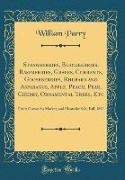Read more
Excerpt from Strawberries, Blackberries, Raspberries, Grapes, Currants, Gooseberries, Rhubarb and Asparagus, Apple, Peach, Pear, Cherry, Ornamental Trees, Etc: Fruits Grown for Market, and Plants for Sale; Fall, 1890
Nut culture is an industry that until recently has received but little attention. The large returns of to from individual trees and the immense profits from established orchards have stimulated the interest, and our foremost enterprising fruit growers are planting nut trees largely for market purposes; and others who enjoy the nuts during winter are realizing that in order to have an abundant supply it is only necessary to plant the trees, as hardy varieties are now grown that succeed in all sections of the United States.
A Kentuckian, who has two hundred Chestnut trees and about three hundred Walnut and Butternut trees, says his income from them year by year is larger than that of any farmer cultivating three hundred acres of ground. He sells his crop on the trees for cash and the only expenses are for taxes.
A gentleman in Georgia, Mr. H. C. Daniels, has a Pecan tree which bears annually from ten to fifteen bushels of nuts, which sell readily at wholesale for four to five dollars per bushel. An orchard of Pecans set thirty feet apart each way, requiring forty-eight trees to the acre, at above rates would give handsome returns.
About the Publisher
Forgotten Books publishes hundreds of thousands of rare and classic books. Find more at www.forgottenbooks.com
This book is a reproduction of an important historical work. Forgotten Books uses state-of-the-art technology to digitally reconstruct the work, preserving the original format whilst repairing imperfections present in the aged copy. In rare cases, an imperfection in the original, such as a blemish or missing page, may be replicated in our edition. We do, however, repair the vast majority of imperfections successfully; any imperfections that remain are intentionally left to preserve the state of such historical works.

